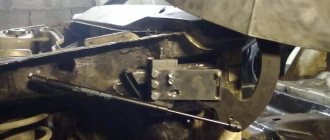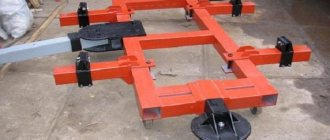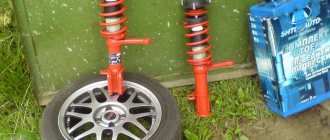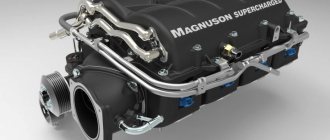Purpose of bracelets
To improve cross-country ability, drivers install tires with deep treads and a specific pattern on their “iron horses.” This type of rubber provides reliable grip on snowy and sticky surfaces. But on normal roads it makes a lot of noise and increases fuel consumption due to high resistance while driving.
An easier way is to equip your car with anti-skid devices. For driving on snow and mountain roads, an anti-slip chain is usually used. But it has one significant drawback: to put it on the wheels, you have to jack up the car.
Anti-slip bracelets perform the same function as chains, but without the disadvantages inherent in the latter. They are easy to install without a lift. It’s not too late to do this, even when the car is already stuck in mud or slush. If the car does not sit on the bottom, the anti-skid chain works as a lug and helps to get out of the hole. In addition, making anti-slip bracelets yourself is not at all difficult.
conclusions
We examined in detail the manufacturing scheme, installation, as well as the main advantages and disadvantages of anti-skid bracelets for cars. If you doubt that you can make the correct design yourself and take into account all the features of the machine, then it is better to turn to specialists. The main thing to remember is that snow bracelets will ensure you and other road users can drive safely on any route.
Almost every driver dreams of his car having excellent cross-country ability. In order for a road of any quality to be passable in snow and muddy conditions, the car must have anti-slip bracelets on the wheels all year round. But how to make anti-slip bracelets with your own hands?
Installation of bracelets on wheels, mounting options
Installing bracelets on wheels is not a particular problem. There are several mounting options you need to be aware of. The difference between them is quite significant:
- The first option is to install bracelets only on the rear wheels. This method is especially relevant for cars with front-wheel drive.
- The second option is to install only on the front wheels. Accordingly, it is most effective for cars with rear-wheel drive.
- The third method is to install on all 4 wheels. The most reliable and safe option, guaranteeing maximum grip on the road.
The main rule, regardless of the fastening method, is an even distribution of bracelets. That is, if you attach a total of 3 belts to a wheel, then this must be done at an equal distance from each other. Only this method will minimize rubber wear and achieve precise anti-skid performance.
Dressing rules
Installation of chains can be carried out in two ways - it all depends on the type of device, weather conditions and your skills.
The first method is using a jack.
Everything is simple here. It is necessary to secure the car with special stops and set the parking brake.
Next, lift each wheel one by one with a jack, put on the chain, and snap the locks.
Second way.
Requires certain skills (no jack needed). Park the machine on a level area and place the chains in front of the wheels.
Make sure that the locks are located on the outside. It is very important that the links and nodes are not twisted.
Now all that remains is to smoothly lay out the snow chains in front of the wheels and drive over them. In this case, about 25-30 cm should remain to the end.
Next, a long section of chain is thrown onto the wheel, and the inner and outer parts are fastened. That's all. All that remains is to tighten the product with an adjusting cable.
Before crossing any obstacle, it is advisable to drive a few tens of meters on the chains, tighten them and then hit the road.
Otherwise, the effectiveness of the products will decrease.
Quality wheel chains can turn your vehicle into a powerful all-terrain vehicle. All you need is to buy the design you like or make your own chains.
What kind of chains can there be?
The crossbars can be made in the form of a ladder, a diamond or a honeycomb. Each of these options has positive and negative aspects. The ladder is characterized by improved rowing capabilities. It is better to resort to it if you need to overcome a muddy section of the road. However, you should be aware that such anti-skid bracelets can cause the wheel to become stuck. Therefore, the ride should be “pull-in”. The driver may encounter other problems. The car will have poor lateral stability. The tires will begin to wear out faster. The gearbox and steering will be subject to more severe shock loads
Wheel anti-skid bracelets with a honeycomb pattern will cause less damage to the main components of the vehicle. The tires will also last longer. Compared to a ladder, such patterns can provide better lateral stability. Constant contact with the surface will also be obtained.
Ways to increase vehicle cross-country ability
To improve the vehicle's maneuverability on muddy or snowy road surfaces, drivers use various methods to improve the traction of tires on a sticky road.
There are two ways to improve a car's cross-country ability:
- Buy and supply tires with deep treads with a certain pattern, for example, herringbone.
- Buy or make your own bracelets or snow chains.
A FullFree device has appeared, which, according to manufacturers and sellers, reduces fuel consumption and protects internal combustion engine parts from low-quality fuel. Let's find out whether fuelfree experts are telling you whether it's a scam or true.
Using the second option, to put on the chains, you need to use a jack or by unfolding the chain and driving over it, followed by fixing it.
Materials and features of bracelets
Devices can be made of different materials, but the most common ones are:
- devices made of durable alloy steel;
- reinforced rubber fibers;
- polyurethane;
- bracelets made of high-strength plastic.
The more severe the road conditions, the more rigid the design of the device should be and the stronger the material should be. So, for shallow snow on hard compacted soil or asphalt, softer lugs are used and speed limits may not apply to them.
The use of traction control devices also depends on the diameter of the vehicle's wheels. Depending on the nature of the coating, choose a lug pattern: for deep snow it is more advisable to use a ladder; honeycombs and diamonds with a smaller pattern are intended more for icy roads.
Design and types of anti-skid means
These devices are based on a simple design consisting of steel links or reinforced wire. A successful application is to distribute the elements evenly over the entire radius of the tire. Failure to comply with this condition may result in rupture of the product and loss of anti-slip properties. The classic scheme, tested by more than one generation of motorists, consists of internal and external components that run along the entire circumference of the tire. They are connected to each other by transverse parts, the so-called “lugs”. The technology for making a chain for wheels with your own hands is accessible even to beginners. Depending on the arrangement of structural elements, there are three types of devices:
- in the shape of a ladder;
- in the form of a honeycomb;
- in the shape of rhombuses.
Each type has its own advantages and disadvantages. In terms of labor costs, the first option is the most accessible - “ladder”.
What are the dangers of using snow chains?
The following negative consequences are possible with constant use of snow chains:
- The load on the steering device increases.
- The suspension wears out quickly.
- The chains make a lot of noise when driving.
- Tire wear increases.
- Unable to maintain high speed.
- It's not comfortable to move around.
Do not use these hard type devices when driving on asphalt roads - this will damage the road surface. Observe the speed limit: for hard ones - no higher than 80 km/h, for soft ones - no more than 50 km/h. Use such equipment only in emergency situations to increase cross-country ability. Homemade hooks (mordovkas, anti-skid belts, anti-slip tapes) are suitable for any car - Gazelle, truck, tractor, UAZ, VAZ, Niva and others.
Ready-made anti-slip bracelets
If you don’t want to make your own anti-slip bracelets, you can always purchase a ready-made version. The stores offer a huge assortment of a wide variety of options, differing in both quality and price. You should definitely choose, taking into account the characteristics of your car, as well as the factors of the area where you are going. Having visited the store, you can immediately understand that the finished products are divided into “soft” and “hard” options. Let's look at what their differences are.
Making your own anti-slip bracelets
Do-it-yourself anti-slip tapes are made exactly to the size of the wheel. Before purchasing materials, you should measure the width of the tire and calculate the optimal number of products.
Materials for bracelets
To make your own anti-skid bracelets, you will need:
- chain with welded links with a diameter of about 4 mm (at the rate of 2 tread widths plus 14-15 cm per one anti-axle box);
- slings for securing cargo (trucks) with a spring lock;
- 2 M8 anchor bolts;
- 2 steel tubes for making bushings with a diameter of 8-10 mm (so that the anchor fits freely into them) and a length of about 4 cm;
- self-locking nuts for M8;
- washers for anchors that do not pass through the chain link;
- thick nylon threads.
Load securing slings with spring lock
For work you will need an awl, a gypsy needle, and wrenches for nuts and bolts. Slings can be purchased at construction and travel supply stores.
Step-by-step instruction
The anti-slip bracelet is assembled in the following order:
- There is a washer on the M8 bolt.
- The last link of the chain.
- Another puck.
- Metal tube as a bushing.
- Third puck.
- Link of the second chain.
- The last puck.
- Self-locking nut (tighten firmly).
Next, you need to make the second half of the product in the same way. What remains after is:
- Pass the first track under the bushing and pull it out 10 cm.
- Sew the end of the strobe thrown over the bolt to its main part.
- Put on a lock or buckle.
- Attach the second strap (without a lock) to the other part of the bracelet in the same way.
For more convenient tightening, it is better to make the ribbon with a free end (without a buckle) longer.
How to make bracelets for wheels?
To make wheel bracelets with your own hands, you will need the following materials to assemble one such device:
- Measure the width of the tire and buy two pieces of length the width of the tire is “plus” 7 centimeters. The chain should be chosen so that you can insert an M8 bolt (metric bolt with a diameter of 8 mm) into the chain link. The joints of the links must be welded. Large chain links will provide better traction than smaller ones. You should also consider the minimum distance from the tire pattern to the fender arch. It is necessary to install such a chain so that there is a normal distance to the wing arch, otherwise, if dirt gets under the chain, it can touch the wing.
- You will need 2 M8 bolts.
- Two steel tubes, approximately 4 cm long and 8.5 mm in diameter, so that the bolts can pass through them freely. If there are no tubes, then you can use nuts with a larger diameter than M8; you need 8 of them.
- You will need two self-locking nuts for the M8 bolts.
- The washers have an internal diameter of 8 mm, and an external diameter so that they do not fit into the chain link.
- A belt with a metal buckle or one sling called a traksa.
- Belt without buckle or one sling.
- Thick nylon threads.
What is needed to make homemade car snow chains for wheels?
The inability to purchase factory-made devices that increase cross-country ability, as well as their high price, push car enthusiasts to solve the problem on their own. It should be noted that this is a completely reasonable choice - the necessary components can be found in any hardware store, and every self-respecting driver has a minimum set of tools.
It should be said that information on how to make snow chains with your own hands and videos do not always include a list of design elements. Let's focus on the simplest model, made according to the “ladder” scheme. To implement it you will need:
- chain with a cross section of at least 5 mm made of steel;
- carabiners with a threaded coupling;
- tension mechanism;
- washers, bolts and nuts;
- hooks, carbines.
On average, to assemble chain devices for the drive wheels of a passenger car, about 15 meters of chain will be required; more accurate figures will be known only after specific measurements. It is recommended to use stainless metal hardware as chains. The preparatory process ends with the collection of tools:
- Bulgarian;
- vice;
- hammer;
- set of wrenches.
Main stages of work
First you need to cut four pieces of chain to the appropriate length. To do this, measure the required size and cut it with a grinder.
And after that, you will need to thread straps with a lock into the prepared sections of the metal chain (in the first and last link). Four pieces of chain will require eight straps.
And in the end we get ready-made “elements” - now you just need to install them on the wheels. No one should have any problems with this.
Such “shoes” are unlikely to be suitable for a long drive, but if you need to go out for a short time, then homemade chains will do just fine. Moreover, the cost of materials is cheap. For details on how to make snow chains on car wheels in 15 minutes, watch the video on the website.
How do they travel with them?
Even the best anti-skid devices, which are made by yourself, are not a panacea for off-road conditions.
A car equipped with bracelets requires special attention. A lot depends on what kind of surface the road has. On a slippery, steep climb, in mud and clay, or in dense snow, the bracelets perform well. Attempts to use them in sand or loose snow may not yield results. If in the summer the car gets stuck in a high rut or the body sits on the ground, then there is a high probability that the bracelet will be useless. Moreover, the wheel dressed in it will sink more and more into the ground. Here you will need a shovel, a winch, a tow rope and a tractor. Similar problems arise in winter, when the snow is loose and the temperature is close to zero. The bracelets turn out to be useless, digging a hole under the car.
It is also important to strictly observe the speed limit when driving with an anti-skid device. It is unacceptable to drive with bracelets on snow or ground at a speed of more than 40 km/h. If you have rocky or icy ground under your wheels, you must drive especially carefully at a speed of no more than tens of kilometers per hour.
Service
Sometimes making such products yourself is easier than caring for them regularly. A car with bracelets in the trunk regularly overcomes off-road conditions with their help. After this, the bracelets are thrown back into the trunk. Once again it turns out that the chain on them is rusty, the belt is torn, and the lock does not hold it. In addition, the tire where it was placed shows signs of wear.
Therefore, you should adhere to several basic rules for caring for the work of your hands:
Bracelets made by hand from high-quality materials are usually not inferior to factory-made products in their efficiency and durability. However, so that the efforts expended do not go to waste, they must be properly operated and maintained in working order.
Manufacturing technology
First, the chain is divided into equal parts in accordance with the number of bracelets that are planned for installation. To do this you just need to take into account the thickness of the wheel. For example, for 215 tires, two pieces of chain of 15-17 links each will be enough. everything is calculated empirically, the main thing is that the chain segments are the same.
When the chain is divided into segments, the bracelets are connected in two pieces of chain using a bolt with a diameter corresponding to the size of the link and a length of 50 mm. To ensure that the ends of the chain are fixed and do not move while moving along the bolt, either a bushing of the appropriate length is put on it, or nuts are screwed on so that the end of the second section of the chain is firmly attached.
It is better to use a self-locking nut or flare the thread to prevent spontaneous unscrewing. When the bracelets are ready, their ends go around the wheel and are connected with rigging straps.
After installing the device on the car, it is recommended to drive a couple of hundred meters and check the strength and reliability of the structure. Naturally, with bracelets, the maximum speed will be limited at the discretion of the driver, but it is not recommended to exceed the barrier of 50-60 km/h on a flat road, and to stick to 20 km/h on off-road roads.
So a simple device can make any road passable and any point accessible all year round. Do not exceed the speed limit with bracelets, and have an easy road for everyone!
Project of an anti-skid device for a car
We were inspired by last year's research to get creative. Then we chose what was better to buy: chains or anti-slip bracelets. The verdict was that there is nothing to do with anti-slip belts on serious off-road conditions. In addition, the cuffs damage alloy wheels, which is critical for many owners. But the real help in making something with your own hands was the price list for the Konig chain. Last year they demanded about 9,000 rubles for the ZIP Ultra model. For a moment, for the same money a ready-made set of winter tires with above-average quality for the now popular 15-inch is sold. Agree, this is impressive.
Choosing a chain weaving pattern
Before purchasing and making anything, you need to have a project in hand: this principle underlies any serious invention and the tire chain is no exception. When designing wheel attachments that increase your vehicle's ability to maneuver in snow, it is important to choose a weaving pattern that suits your needs.
| Ladder | Honeycomb | Rhombus |
| +The most powerful traction force + Low price + Simplicity of design | +Excellently storms the rut +Smooth running on hard ground +Best handling in class +Good lateral grip | +Excellently gets out of ruts +Good handling |
| - Doesn't get out of a rut —Worst lateral grip in class —Increased load on transmission units on hard surfaces | —Average traction level | —Rows mediocrely —Does not prevent the machine from sliding sideways —High vibration load of the transmission |
| Suitable for driven axle | The best choice for mountain roads and light off-roading | Not recommended for use. Pay attention to the honeycomb or ladder |
Link size
Not just a drawing. The caliber of chain links also determines a number of important characteristics, including cross-country ability and durability. This way, a thin chain won’t last long, but a larger option may not fit into the wheel arch. Strictly speaking, in this matter you should not focus on just one parameter:
- As the caliber increases, traction capabilities in snow and mud improve, the service life of the anti-slip product increases, but rubber wear occurs.
- Small-link snow chains cling to ice well, have a moderate appetite for rubber, but wear out quickly. This is abstract reasoning. For each class of car, “working” ranges of link sizes have long been determined and, admittedly, they grow with increasing vehicle weight:
- Passenger cars and crossovers: 3.5-6 mm. Our colleagues from Autocomfort have experimentally determined that it is better to equip a two-ton SUV with 6 mm chains. It’s even better to choose an asymmetrical shape of 6x8 mm - then the machine demonstrates everything that it is capable of. As for the smaller size, a 5 mm chain will be too small for those over 2,000 kg.
- Trucks and special equipment: 6-19 mm.
Accessories
When you see branded kits, it becomes clear that the anti-skid device does not consist of one chain at all. The design also provides:
- Two connecting lines linking the chain sections at the back and front of the tire.
- A tightening device that tightly fixes the chain on the wheel (lock).
- Fasteners that fasten metal sections together directly on the tread (connecting rings).
What exactly can serve as one or another component is determined by the budget and range of equipment available. Here are examples for each of the three groups of fittings:
- The best option for connecting lengths of chain on the sides is to use a chain of the same gauge. In this situation, maximum strength and durability are guaranteed. The only thing that discourages this decision is the high cost. This is why the second version appeared - to use a cable for these purposes. A linear meter of cable rope is noticeably cheaper, but it can fray and unravel, and is therefore less reliable.
- The signature chain tie is also made from chain. It is difficult to implement such a solution in everyday life, so turnbuckles and peculiar locks, known from anti-slip devices “Made in the USSR,” have taken root on homemade products. The widespread use of lanyards is due to their availability in retail sales and the absence of the need to make anything with your own hands. At the same time, such a fastening scheme has poor dirt protection. This led to the belief that the turnbuckle was difficult to loosen after several trips. The advantage of the Soviet lock design is reliability and trouble-free operation. However, the lock has only one drawback: it is difficult to manufacture (additional equipment is required).
- The easiest way to connect straight and diamond-shaped sections in the tread area (applies to “honeycomb” and “diamond” weaving patterns) is to use special rings. If it is difficult to get them, then you can get by with a well-known technique: cut the link with a grinder, engage it and weld it with a welding machine.
The listed accessories are the backbone of the anti-slip device. Depending on the manufacturing technology, a number of mandatory parts are selected:
- Cable circuit for linking the chain on the sides of the tire. Additionally, you will need thimbles, shackles and clamps to secure the cable from unraveling.
- Chain linkage on the sides of the wheel. What is needed are plates connecting sections of the chain along the perimeter of the front and rear walls of the tire + removable brackets used on the section of fastening the lock/turnbuckle.











